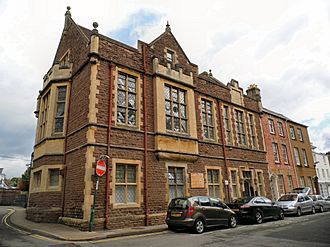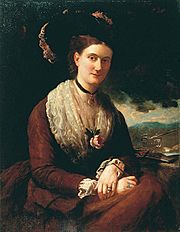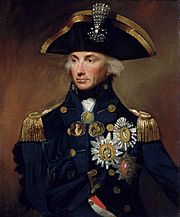The Nelson Rooms, Monmouth facts for kids
Quick facts for kids The Nelson Rooms, Monmouth |
|
|---|---|
 |
|
| Alternative names |
|
| General information | |
| Address | 2 Glendower Street |
| Town or city | Monmouth |
| Country | Wales |
| Coordinates | 51°48′41″N 2°42′54″W / 51.8113°N 2.7150°W |
| Design and construction | |
| Architect | Benjamin Lawrence |
| Designations | Grade II Listed |
The Nelson Rooms is a historic building in Monmouth, Wales. It is located on Glendower Street, close to the old medieval town walls. This building was first a gymnasium, given to the town by Lady Llangattock. Later, in 1924, it became the Nelson Museum, showcasing items related to Admiral Horatio Nelson. The museum moved in 1969. Today, The Nelson Rooms building has been turned into apartments. It is a "Grade II listed" building, meaning it is an important historical structure protected by law.
Contents
The Nelson Rooms: A Look Back
The Nelson Rooms, found at 2 Glendower Street in Monmouth, was built in the late 1800s. It stands at the corner of Glendower Street and Agincourt Street, inside the old medieval town walls. The building's outside look has not changed much since it was first built.
Lady Llangattock's Gift to Monmouth
The building was a gift from Lady Llangattock (1837–1923) to the town of Monmouth. She built it as the Working Men's Gymnasium. Lady Llangattock, whose full name was Georgiana Marcia Maclean, was married to John Allan Rolls, 1st Baron Llangattock.
Their youngest son was Charles Stewart Rolls (1877–1910). Charles helped start the famous car company, Rolls-Royce Limited. He was also very interested in flying. Sadly, in 1910, he became the first Englishman to die in a plane crash. Lady Llangattock faced personal losses, losing her husband and all three sons within six years.
From Gym to Museum: The Nelson Collection
Lady Llangattock gave the Working Men's Gymnasium to Monmouth in the late 1800s. In 1901, a local directory mentioned it as the Monmouth Gymnasium. Lady Llangattock was a big collector of items related to Admiral Horatio Nelson. She left her amazing collection to Monmouth when she passed away in 1923.
The Nelson Museum opened in the former gymnasium in 1924. Lady Llangattock's collection became the main part of the museum. One special item was a set of leather books containing letters from Horatio Nelson to his wife. One of these books even held Lady Nelson's wedding ring.
In 1969, the Nelson Museum moved from Glendower Street to its current home at the Market Hall on Priory Street. This move happened six years after a fire had damaged the Market Hall. Today, the Monmouth Museum is also known as the Nelson Museum and Local History Centre. It includes information about Lady Llangattock's famous son, Charles Stewart Rolls, and local Monmouth history.
Building Design and Features
The Nelson Rooms building was likely designed by Benjamin Lawrence. He was an architect from Newport who also designed other buildings for Lady Llangattock in Monmouth. The building got its current name, The Nelson Rooms, because the Nelson Museum used to be there. It was officially made a Grade II listed building on October 8, 2005.
New Life for a Historic Building
After the museum moved out in 1969, the building was used for auctions for a while. More recently, it has been changed into apartments. In 2006, permission was given to turn the building into three flats. Later, in 2008, more changes were approved to continue its use as apartments.
Architectural Style of The Nelson Rooms
The building has one side facing Glendower Street and its pointed end (called a gable) facing Agincourt Street. It is a two-story building from the 1800s. The first floor is much taller than the ground floor. It is built from red sandstone rubble (rough stones). It has contrasting light-colored Bath Stone blocks (called quoins) and decorative trim.
The side facing Glendower Street has a special window that sticks out, called an oriel window. This window has a decorative top that looks like castle battlements (called a castellated parapet) and a stone base (called an apron). The side facing Agincourt Street has another type of bay window and a window with a castellated parapet and apron. Three decorative stone bands (called band courses) run around the outside of the building.



